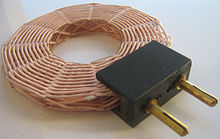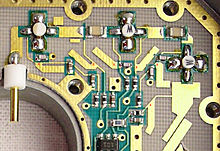Series resonance
Series resonance , also voltage resonance or series resonance, are designations for the impedance minimum of electronic circuits in the vicinity of a resonance frequency. Series resonant circuits have only one resonance frequency, other circuits have several.
This low impedance is used in the suction circuit to short-circuit unwanted frequencies.
Resonance in the series resonant circuit
Inductances and capacitances have a frequency-dependent reactance . This means that the impedance of a series connection of R, L and C is also frequency-dependent:
When the term becomes zero, the impedance is minimal and a pure, real effective resistance . From this, the frequency at which the resonance occurs - the resonance frequency - can be determined through transformation and resolution . The Thomson equation is obtained :
Because the impedance is minimal, the current through the circuit reaches its maximum value at resonance and can be calculated according to Ohm's law when the terminal voltage U is applied
Resonance voltage on components
Another effect occurs at the reactances X L and X C in the event of resonance: The voltage at both becomes the same amount, the so-called resonance voltage :
You reached out in case
Values substantially greater than the applied terminal voltage U may be. This voltage increase is required for energy-saving lamps and the backlighting of notebooks in order to be able to operate the gas discharge lamps. This circuit property is the origin of the alternative term voltage resonance for the series resonance.
Phase angle
The phase angle ( phase shift ) at resonance is
so no phase shift, as the circuit behaves like a pure resistance.
Circular quality
The circular quality Q, also the quality factor , resonance exaggeration or resonance sharpness, is the reciprocal of the loss factor d. For the series connection of R, L and C one obtains:
This gives for the resonance voltage:
special cases
Series resonance with all its accompanying phenomena can also be observed in resonators , where no capacitors or coils can be seen, but rather is due to the technical structure. Then undesirable and inevitable side effects can occur. In the vicinity of the series resonance, the impedance is considerably lower than expected.
Series resonance in capacitors
Every capacitor requires connecting wires that are shown in the equivalent circuit diagram as inductance that forms a series circuit with the capacitor. This ESL ( equivalent series inductance L ) together with the capacitance leads to a characteristic natural resonance at which the impedance of the arrangement becomes minimal. This effect is even more pronounced in wound capacitors, the foils of which are wound like a coil. For this reason, wound capacitors are often unsuitable for high frequency purposes.
If an application requires a low impedance over a wide frequency range, capacitors of different types are connected in parallel. It is known to connect an electrolytic capacitor in parallel with a ceramic capacitor or to connect ceramic capacitors of different sizes in parallel.
Series resonance of coils
Coils not only have a low capacitance between the connecting wires, but also between the individual turns. Together with the inductances in between, a structure of distributed L and C is created which - similar to a dipole - has several resonance frequencies that can be calculated using the formulas of line theory .
If a long cylinder coil is fed with high-frequency current, an oscilloscope can be used to measure the voltage as a function of length. If this follows a function shown in the picture, there is series resonance although no capacitor can be recognized. The total voltage of the coil is then very low and comes close to a selective short circuit. The total impedance is considerably smaller than the calculated value of the inductive resistance.
The lowest resonance frequency can be increased with a special winding technique. In a cross- wound bobbin , the mean distance between successive turns is considerably greater than in the case of a conventional cylinder winding , which reduces the capacity of successive turns. Elongated, single-layer wound solenoids have the highest natural resonance frequency. With a large number of turns, such as the secondary coil of a Tesla transformer , however, it drops to around 500 kHz. A rule of thumb is that the lowest series resonance corresponds to a (vacuum) wavelength that is about twice as long as the wire length of the coil.
Series resonance in quartz crystals
In many electronic circuits, oscillating circuits are replaced by oscillating crystals because of their sometimes considerably better properties. Although these crystals do not have any coils or capacitors, they show all the properties of series resonance at very specific frequencies. Starting from the lowest frequency, these behave like 1: 3: 5: 7:…, are extremely stable and have significantly higher quality factors than oscillating circuits, which is why quartz oscillators are used as clock generators in clocks and transmitters. All quartz crystals have parallel resonance at a slightly higher frequency.
Series resonance in lines
With devices in the radar range, the property of stub lines is used to transform the terminating resistor depending on the length L (see line theory ). Striplines are shortened because of the permittivity of the insulating substrate.
- If L = λ / 2 and one end is connected to ground, one also measures zero ohms at the other end. This piece of wire acts like a suction circuit at the wavelength of the series resonance and like a short circuit for direct current. This applies unchanged if the wire length is doubled or tripled.
- If L = λ / 4 and one end is free, i.e. has no connection to other components, a series resonance is measured at the other end, i.e. a particularly low impedance. The short piece of wire acts like a perfect blocking capacitor at this wavelength and replaces it in LNBs . In the adjacent picture you can see six λ / 4 lines, the starting points of which are marked with a red x .
























